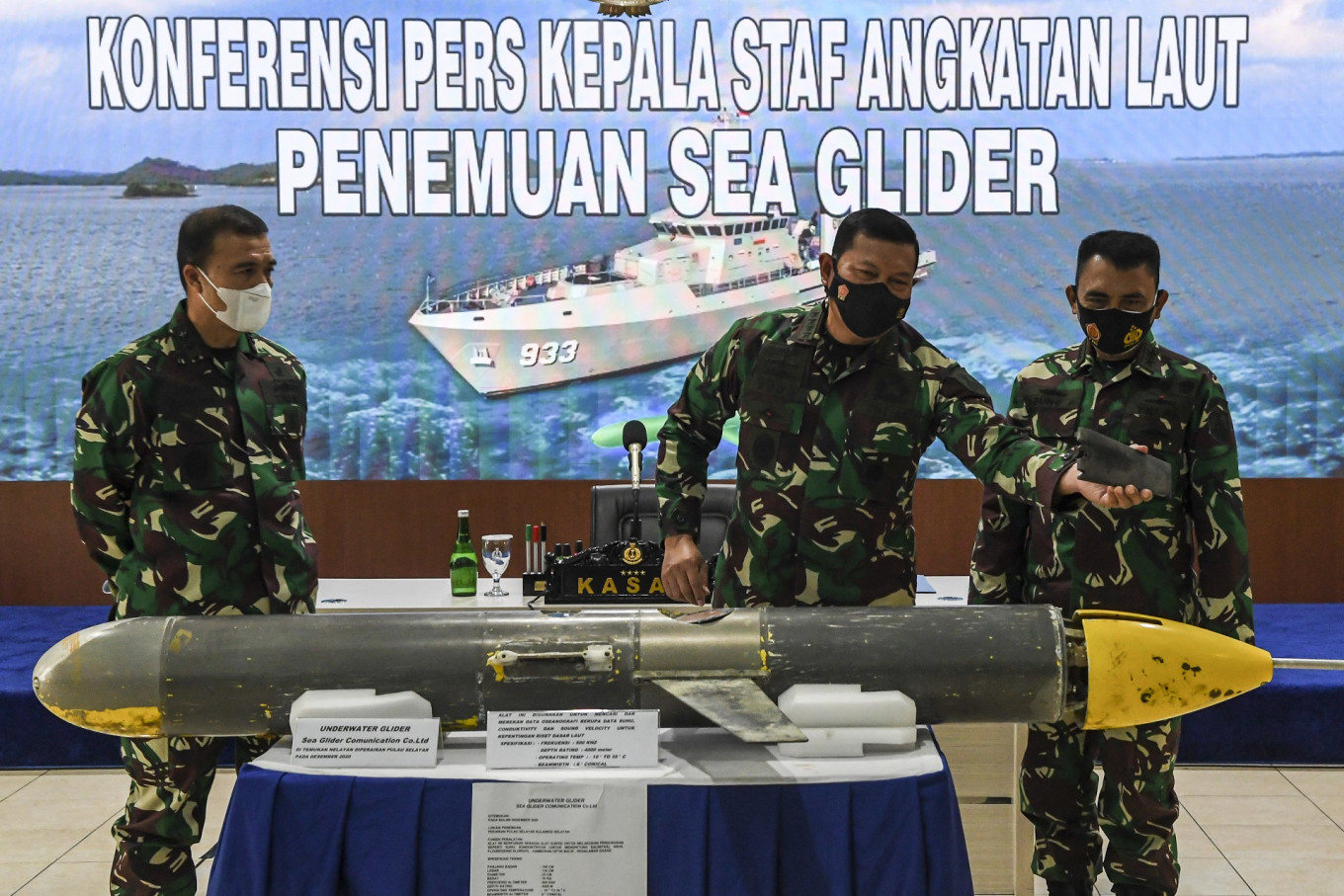Popular Reads
Top Results
Can't find what you're looking for?
View all search resultsPopular Reads
Top Results
Can't find what you're looking for?
View all search resultsDiscovery of unmanned underwater vehicle highlights legal vacuum
The discovery of an unmanned underwater vehicle (UUV) in Indonesian waters highlights the lack of a legal basis to deal with such devices.
Change text size
Gift Premium Articles
to Anyone
T
he discovery of an unmanned underwater vehicle (UUV) in Indonesian waters late last year has highlighted the lack of a legal basis to deal with such devices.
Fishermen in waters off Selayar Island, South Sulawesi, found the UUV on Dec. 26. It was found floating on the sea surface and had a camera-like device attached to it.
The Indonesian Navy said it had not yet determined the origin or which party operated the device, as it had no markings or writing. Nevertheless, speculation has arisen that the device was used for espionage and had violated Indonesia’s national sovereignty as it was found in territorial waters.
It is not the first drone-like device discovered within Indonesian territory. In 2016, authorities found a seismic survey device developed by Norway-based Partner Plast AS near Natuna Islands.
Since then, authorities have found at least seven suspicious devices developed by different countries, including China.
Indonesian Defense University rector Vice Adm. Amarulla Octavian said Indonesia should strengthen its underwater defenses, as UUVs would play a more significant role in the future. He added that countries had different ways to deal with such occurrences, since no international or national maritime law existed to deal with UUVs.
“International law, including the 1982 United Nations Convention for the Law of the Sea, has no specific [stipulations] yet about unmanned vehicles and unmanned subsurface vehicles,” Octavian said during a discussion on Thursday.
He added that the International Maritime Organization (IMO) had started talks to include provisions on possible encounters with unmanned maritime vehicles at the Convention on the International Regulations for Preventing Collisions at Sea.
Octavian also urged the Indonesian government to devise procedures for dealing with underwater devices following the December discovery.
According to the Indonesian Navy, the UUV operates in a similar fashion to an Argo float – referring to international cooperation that uses robotic instruments to observe the temperature, salinity and currents in the oceans.
While such UUVs are used mostly in hydrography and oceanography surveys, they can also be used for industrial or defense purposes, Indonesian Navy chief of staff Adm. Yudo Margono previously said.
Indonesian authorities have largely refrained from pointing fingers due to a lack of incriminating proof of the drone’s ownership, although several reports claimed the vehicle was likely manufactured by China. Beijing has remained silent on the issue.
Indonesian diplomats should seek answers from their Chinese counterparts to ascertain the origin of the device, international maritime law expert Hasjim Djalal said.
“Of course, we have to be careful, because I believe that not only China but also other countries have an interest in monitoring [vessels] that pass Indonesia’s waters,” he said.
Hasjim went on to say that he suspected there was other military and observation equipment as well as underwater drones owned by foreign countries on Indonesia’s seabed.
Experts believe that Chinese top diplomat Wang Yi’s visit to Indonesia on Jan. 13 served as the perfect opportunity to raise the issue. Wang met with President Joko “Jokowi” Widodo, Coordinating Maritime Affairs and Investments Minister Luhut Pandjaitan and Foreign Minister Retno LP Marsudi during his short visit to the Southeast Asian country.
But Luhut’s adviser for maritime security, Adm. (ret.) Marsetio dismissed it, saying the issue was “not that significant.”
However, Marsetio assured that Indonesian officials had worked hard to establish the device’s origin. He also suggested that authorities be more involved in maritime scientific collaboration between Indonesian and foreign institutions.
An example of such cooperation was joint research between Sam Ratulangi University in Manado, North Sulawesi, and the Chinese Academy of Sciences’ Institute of Oceanology in 2018 and 2019 on the subsurface ocean in Maluku.
For scientific observation, students of Sam Ratulangi University launched sea gliders that were linked with satellites transmitting data to the Chinese institution.
“We should be [involved] in these arrangements, so that we can check the extent of the cooperation, such as which data can be shared and not,” Marsetio said, adding that he did not know whether the devices found in December were related to scientific research.










